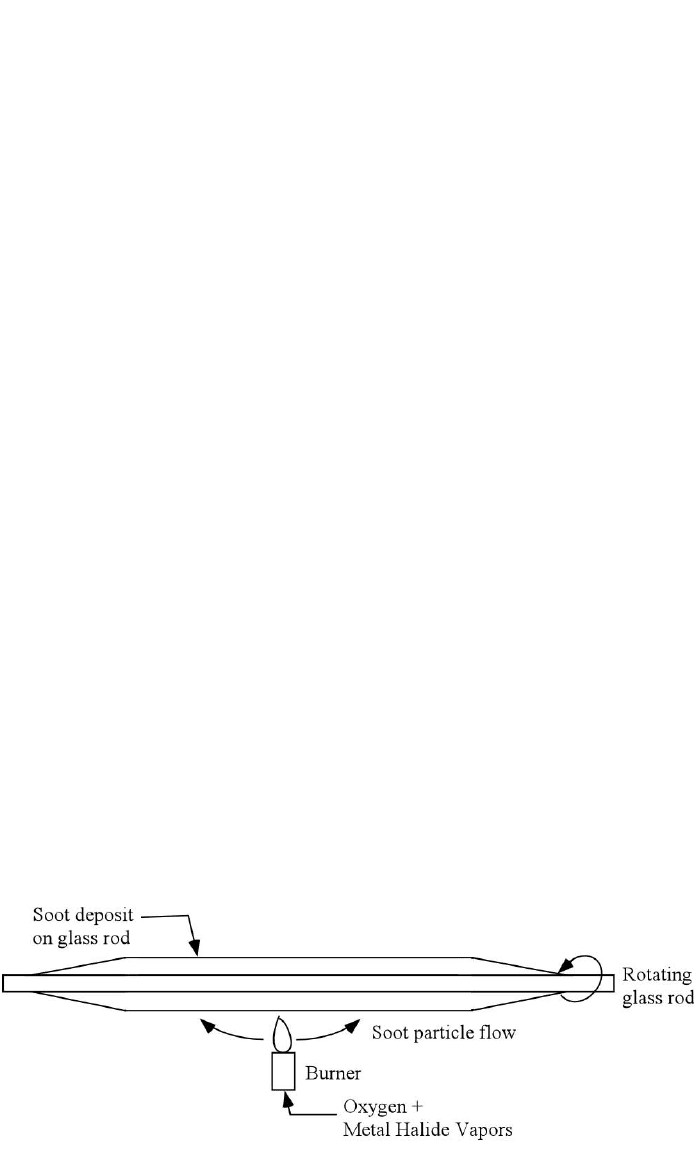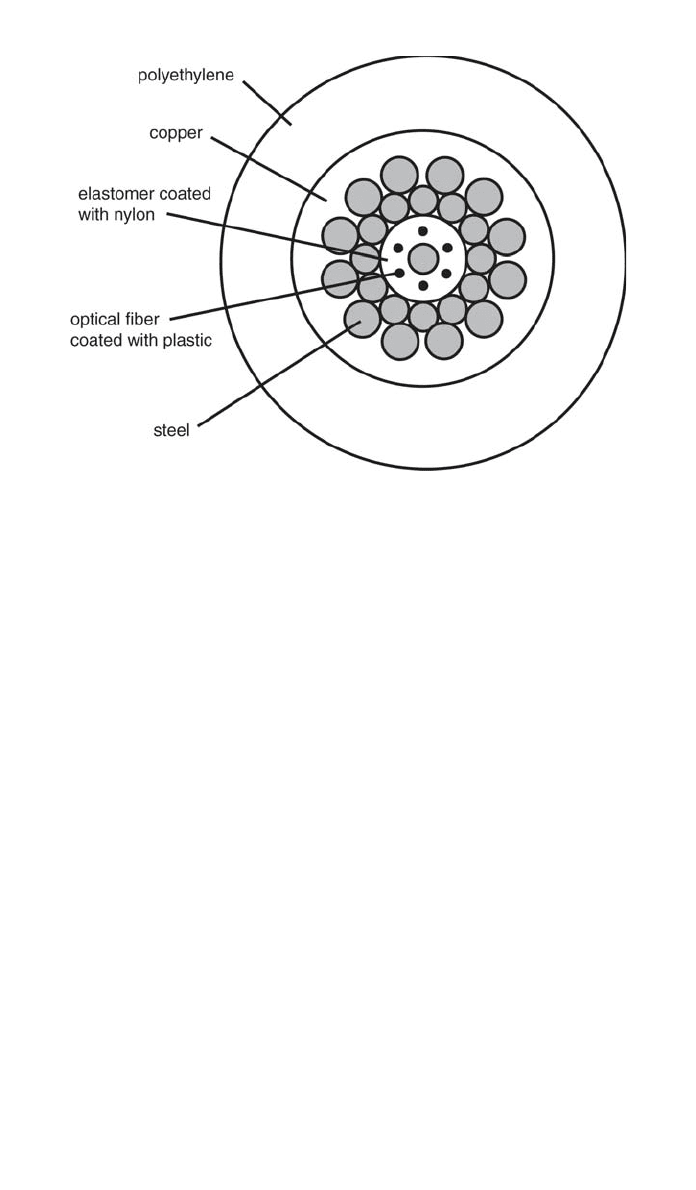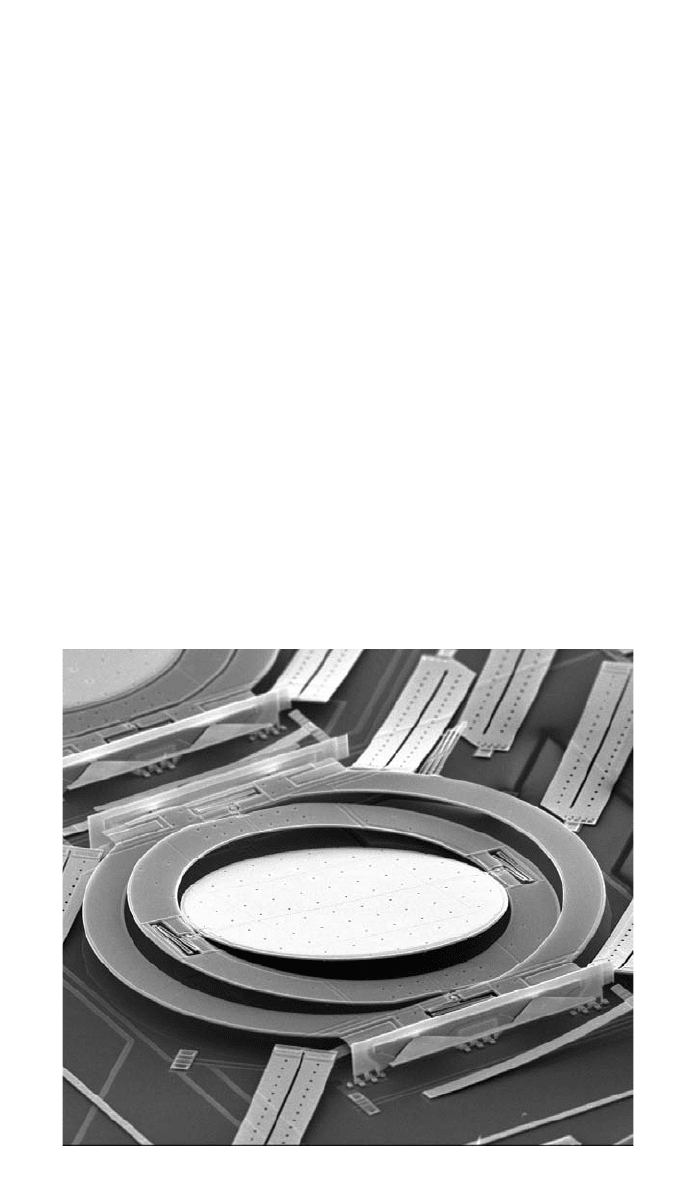Kutz M. Handbook of materials selection
Подождите немного. Документ загружается.


2 MATERIALS SELECTION FOR SELECT COMPONENTS 1321
Fig. 12 Soot deposition onto a rotating rod by the outside vapor deposition (OVD) process.
attention must be paid to eliminate contamination of the crucible and furnace
environment.
In the vapor-phase oxidation process, highly pure vapors of metal halides
(e.g., SiCl
4
and GeCl
4
) react with oxygen to form a white powder of SiO
2
par-
ticles. These particles are collected and are sintered by one of a variety of
techniques to form a clear glass rod or tube. This rod or tube is called a preform,
which is as much as 100 mm in diameter and 100 cm long, yielding hundreds
of kilometers of fiber. Fibers are drawn from preforms in a precision draw tower
furnace. In it, the bottom is softened so that a thin filament of glass (optical
fiber) can be drawn. The thickness of the fiber is determined by the drawing
speed.
The first optical fiber was manufactured by outside vapor-phase oxidation
(OVPO) at Corning Works.
36
A layer of silica particles called soot is deposited
from a burner onto a bait rod, where a porous perform is made layer by layer
(as depicted in Fig. 12). When the desired thickness is attained, the bait rod is
removed, and the porous perform is then vitrified and collapsed into a clear glass
rod in a dry and hot environment (above 1400
⬚C). Other methods exist and are
described in other texts.
31,34
One method, which is a new fabrication point of
view, known as sol–gel, starts from a liquid precursor [e.g. Si(OC
2
H
5
)
4
hydro-
lyzed in water], is dried and sintered into a glass perform.
34
One important type of vapor-phase fabrication is the modified chemical vapor
deposition (MCVD) created at Bell Labs.
37
The process starts with a very pure
tube of silica glass (SiO
2
), about 15 mm in diameter and 1 m long. Reactant
gases of metal halide gases and oxygen flow through a revolving tube, as de-
picted in Fig. 13. As the SiO
2
particles are deposited, they are sintered into a
clear glass by a moving oxyhydrogen torch, which travels back and forth along
the tube. Successive layers of SiO
2
followed by GeO
2
doped SiO
2
are deposited.
When the total deposit reaches the desired thickness, the vapor flow is stopped,
and higher heat is applied to collapse the solid tube. Glass fibers are surprisingly
strong. The longitudinal tensile strengths of 5 GPa in a short length of glass
fiber is larger than the yield strength of steel wire (2 GPa). Unlike steel, glass
does not yield and does not deform plastically. Glass fibers can elongate 1%
more than 10% before fracture occurs. These extraordinary mechanical proper-

1322 ADVANCED MATERIALS IN TELECOMMUNICATIONS
Fig. 13 A schematic of the modified chemical vapor deposition (MCVD) process.
ties of glass fiber derive from the pristine (flaw free) surface of a freshly drawn
fiber. In the drawing process, the fiber is quickly coated with a polymer layer
to protect the surface from mechanical scratches and chemical reactions with
the atmosphere. Commercial optical fibers are routinely proof tested at levels of
0.69 GPa or 1.38 GPa before sale.
Fiber-Optic Cables
Special cable designs are required because of the mechanical properties of glass.
These designs are greatly dependent on how the cable will be used. For example,
cable may be pulled underground, submerged underwater, or installed outdoors.
Generally, a fiber is coated with buffer material and placed loosely in a poly-
ethylene tube. The tube is surrounded by aramid yarn to provide strength and
encapsulation. Finally, an outer jacket of polyurethane, polyethylene, or nylon
binds the encapsulated fibers together. Larger cables are fashioned from these
units by binding fiber bundles to a support with tape, then surrounding them
with an outer jacket. Undersea optical fiber cable, like copper cable, needs to
be protected from water vapor and its mechanical strength needs to be increased.
This is accomplished by forming cables with steel wire strands and polymer
jackets (see Fig. 14).
Fiber Devices
Advances in optical fiber have extended into device fabrication, such as fiber
Bragg gratings (FBG).
38
FBGs are made by doping the core of an optical fiber
with germanium, which increases the index of refraction allowing the guiding
of light. This fiber is masked according to the desired modulation pattern and
exposed to ultraviolet light, which increases the index of refraction in the areas
exposed due to the photorefractive effect. Thus, the core of fiber posseses an
index modulation along the propagation direction, thereby demonstrating Bragg
grating characteristics. These gratings can be used as simple filters where the
reflected wavelength is removed from the transmitted signal. However, many
functionalities can be added to the FBG to monitor network operation and to
permit rapid reconfiguration. For instance, thin-film heaters can be deposited on

2 MATERIALS SELECTION FOR SELECT COMPONENTS 1323
Fig. 14 Cross section of optical fiber cable for undersea deployment.
the fiber, which dynamically compensate for chromatic dispersion during prop-
agation of light in long-haul fiber by adjusting the chirp of the FBG.
39
2.5 Electro-Optical Materials
The area of optoelectronics is demonstrating exploding growth. In the past few
decades, optical communication used fiber as the transmission medium but relied
on electronics for amplification, signal processing, and switching. The conver-
sion of information from optical to electronic to optical represents a bottleneck
in the optical network. It is obvious that faster data transfer will only be possible
if the electronic components are replaced by all-optical counterparts. To manip-
ulate light, materials demonstrating nonlinear optical (NLO) phenomena are nec-
essary. Materials with large electro-optical coefficients also demonstrate
significant NLO behavior. One requirement for all electro-optical materials is a
lack of inversion symmetry in the crystallographic space group, also known as
acentric.
Piezoelectric materials are acentric with a crystallographically defined polar-
ization direction. This direction must be oriented (textured) as deposited if in
thin-film form. For nonferroelectric materials, such as ZnO and AlN, poling is
not required and fatigue is not observed. However, usually nonferroelectric ma-
terials have low electro-optical coefficients and only demonstrate a linear electro-
optical coefficient. These materials are not applicable in nonlinear devices that
utilize the Kerr effect.
40
As mentioned earlier, lithium niobate (LiNbO
3
), is an electro-optical material
that demonstrates a change in index of refraction (n) with applied electric field
(E). High-speed modulators with rates of 40 Gb/s are commercially available.
Waveguides are defined by Ti diffusion, and Au is used as an electrode material.
LiNbO
3
is a ferroelectric material with a moderate electro-optical coefficient,

1324 ADVANCED MATERIALS IN TELECOMMUNICATIONS
and it does not display fatigue. However, due to the photorefractive effect,
LiNbO
3
has a low optical damage threshold limiting it from nonlinear applica-
tions that require high-intensity light.
Another ferroelectric, BaTiO
3
, demonstrates a large electro-optical coefficient
(r
33
⫽ 100 pm/V), but the thermal stability is low due to a Curie temperature
of 120
⬚C, which is too close to ambient temperature. The Pb-based ferroelectrics
(PT
⫽ PbTiO
3
, PZT ⫽ PbZr
1
⫺
x
Ti
x
O
3
, and PLZT ⫽ Pb
1
⫺
3y /2
La
y
Zr
1
⫺
x
Ti
x
O
3
)have
very large electro-optical coefficients, but their properties exhibit fatigue (i.e.,
the electro-optical coefficient decreases with time). In addition, optical attenua-
tion is high since large single crystals have not been grown and epitaxial films
cannot be grown to thicknesses required for optical waveguides (
⬃5–10
m).
One reason to investigate the Pb-based ferroelectrics is their high electro-optical
coefficients (r
c
), which in turn lead to a large change of the index of refraction
(
⌬n) in an applied electric field (E) through the following relationship:
13
–
⌬n ⫽⫺ nrE
2 c
where r
c
is approximately r
33
⫺ r
13
for tetragonal symmetry.
41
Reported values
for r
c
are the following (units of pm/V): BaTiO
3
80, LiNbO
3
18,
Pb
0.88
La
0.08
(Zr
0.40
Ti
0.60
)O
3
100, Pb
0.88
La
0.08
(Zr
0.65
Ti
0.35
)O
3
520.
A new direction pursued to find high-efficiency elecro-optical materials is in
the area of organic materials.
42
The design of organic molecules to crystallize
in acentric space groups with large electro-optical coefficients has been discussed
based on geometrical arguments of rodlike dipolar molecules.
43
In addition,
inorganic-organic hybrid nanocomposites are being developed for electro-optical
applications.
44
2.6 Antireflection (AR) Coatings
Attenuation of optical signals through lenses can be significant. For example,
pure SiO
2
with an index of refraction (n) of 1.5 will reflect 4% of the light from
a single air–glass interface.
45
This attenuation can be reduced to 1% using an
antireflection coating of MgF
2
. The coating consists of a quarter wave film,
meaning the thickness of the film is of the wavelength of light that is desired
1
–
4
to be transmitted. The optimal index of refraction for the antireflection coating
is n
1/2
. Therefore, SiO
2
would benefit most from a film with n equal to 1.22.
Such a low index is difficult to achieve; however, MgF
2
has an index of 1.37 at
1550 nm, making it a good candidate as a coating material. In addition, it is
easy to fabricate using electron beam evaporation. AR coatings are used on
almost every optical element in a device.
2.7 Optical Filters
Selecting an appropriate bandgap and index of refraction, multilayers of inor-
ganic thin films can be designed for use as optical filters. A variety of applica-
tions are available: antireflection coatings, reflective coatings (dielectric mirrors),
neutral density filters, beam splitters, short-wave pass filters, long-wave pass
filters, bandpass filters (monochromatic), minus filters, and shaping filters.
46

2 MATERIALS SELECTION FOR SELECT COMPONENTS 1325
2.8 Isolators Incorporating Faraday Rotators
An isolator prevents light propagating down a optical fiber to reenter a laser
cavity, which disrupts the mechanism of stimulated emission. The isolator com-
bines two polarizers with a Faraday rotator. Light emitted from the laser cavity
is sent through a polarizer to achieve plane polarized light. Then, this light passes
through a Faraday rotator that exactly rotates the polarized light by 45
⬚, which
passes through another polarizer tipped at 45
⬚ to allow the light to pass out of
the isolator. Any light that propagates down the fiber and is reflected back would
undergo an additional 45
⬚ rotation at which point the initial polarizer would
deflect the 90
⬚ out-of-phase light away from the laser cavity, thereby isolating
the cavity.
An iron garnet, (Bi, Eu, Ho)
3
(Fe, Ga)
5
O
12
, has been developed as the material
for Faraday rotators for telecommunications at 1.55
m.
47
This material was
selected for its isotropic optical properties, which arise from cubic symmetry.
The garnet structure can be described by C
3
A
2
D
3
X
12
, where the cations have a
⫹3 oxidation state and reside in dodecahedral (C), octahedral (A), and tetrahe-
dral (D) coordination, and the oxygen anions (X) having a
⫺2 charge reside in
tetrahedral coordination. To increase the specific rotation, bismuth was added
into the dodecahedral site. However, this also increases the temperature depend-
ence of the specific rotation, an undesirable consequence. The reason for in-
creasing the specific rotation is to reduce the thickness of the device. For
instance, yttrium iron garnet, Y
3
Fe
5
O
12
, would require a thickness of 2.7 mm in
order to rotate light 45
⬚, whereas the optimized material is only 0.4 mm thick
to achieve similar rotation. Gallium doping is used to reduce the saturation
magnetization such that the material can only switch between saturated single-
domain states. This permits the use of Faraday rotators in applications were an
external magnet are prohibited, since the rotator will remain in a single-domain
state in the absence of an external magnetic field. In addition, all cations must
retain the
⫹3 oxidation state to maintain minimal optical absorption at 1.55
m.
The polarizers can be replaced by a highly birefringent material to make a
polarization independent device. Rutile, TiO
2
, is one possible material for this
application. In this manner, both components of the refracted light (ordinary and
extraordinary) can propagate through the device without significant attenuation.
Future developments would include thin-film fabrication for integrated optics.
2.9 Microelectromechanical Systems
Microelectromechanical systems (MEMS) is a burgeoning technology that in-
tegrates many of the lessons of integrated circuit technology into small-scale
systems. The thrust for this technology combines the high volumes of production
with low cost. In addition to the economic potential, this approach allows unique
opportunities in the full integration of devices at very small scales. A device
composed of mechanical and electrical elements built on silicon can now sense,
48
actuate,
49
produce power,
50,51
guide light,
52
and maintain chemical reactions.
53
The success of this technology, however, lies in the understanding of the ma-
terials issues associated with the design and fabrication of the tiny devices.
Although the materials set borrows heavily from silicon technology, there are
a few new players in the MEMS arena. MEMS technology extends the materials

1326 ADVANCED MATERIALS IN TELECOMMUNICATIONS
set beyond those of microelectronics to include diamondlike carbon,
54,55
silicon
carbide,
56
metals and polymers,
57
and piezoelectric materials.
58
Silicon process-
ing has also changed its character to create high-aspect ratio devices. For
example, deep reactive ion etch (RIE).
59
Bosch techniques,
60,61
and other
techniques are now used to create deep trenches and other unique geometries
that were not compatible with etching anisotropies of conventional materials.
A host of fabrication techniques
62
are used, including surface machining,
63
bulk machining,
64
and molding processes (or LIGA).
65
Surface machining builds
on top of the silicon substrate, bulk machining relies on etching into the wafer,
and molding produces pieces by microfabricated molds. The basis of micro-
machining is photolithography, which is the means of defining regions on a
wafer. Etching (or removal of silicon), doping, and deposition can all be con-
trolled by photolithography and make up the key ingredients to building three-
dimensional forms. Surface micromachining is comparable to the process to
build VLSI technology. Molding is based on LIGA, an acronym based on the
German phrase for Lithographie, Galvanik (electroplating) and Abformung
(molding). This technique can create high-aspect ratio photoresist regions by
illumination it with high-intensity X-ray radiation (often done with a synchro-
tron). The resist is exposed to form open regions in which electroplated metal
is deposited. The resulting device consists of photoresist and electroplated metals
agglomerations. Other techniques on the horizon for fabrication include conven-
tional techniques such as cutting, shaping, and drilling on a small scale.
66,67
Sand
blasting, laser ablation,
68
and spark erosion may become viable paths to micro-
fabrication as well.
MEMS Materials Set
The pathways to fabrication described above provide designers a means of de-
veloping a host of devices. However, achieving reliable low-cost devices is
strongly dependent on the materials used. The materials set for MEMS consists
of all the flavors of conventional integrated circuit technology, plus a few new
ones. The original materials include single-crystal wafer substrates, polysilicon
resistive layers, and aluminum and copper conductive paths. In addition, silicon
oxide, silicon nitride, and titanium nitride are used for insulation, passivation,
and passivation/protection, respectively.
69
In the MEMS world, these materials
now serve additional functions. Silicon, polysilicon, and silicon nitride are me-
chanical elements, aluminum is used as a reflective material, and silicon oxide
is used sacrificially. Other materials are employed as well. Gold is used as a
reflective material and as a conductive path. Titanium and chromium are used
as adhesion layers, and silicon-on-insulators (SOI) wafers serve as substrate
material. In addition, photoresist was once used and removed in processing; now
it remains as a structural material in MEMS.
57
For materials in MEMS, every-
thing that was once old is now new.
In MEMS, mechanical elements for displacement-based sensors include ro-
tating parts and torsional flexures. Silicon is an attractive material due to its high
stiffness and high strength. Silicon carbide, diamond, and alumina (Al
2
O
3
) are
also good choices for similar applications. For applications in which high me-
chanical forces and power levels are required, metals are a more obvious choice.
Electroplated metals such as copper, nickel, and their alloys are used, as are

2 MATERIALS SELECTION FOR SELECT COMPONENTS 1327
Fig. 15 An optical cross-connect MEMS mirror used to route light from
one optical fiber to another.
other metals such as chromium, iron, cobalt, and strengthened versions of each.
Silicon carbide offers a high stiffness, hardness, and wear-resistant option in the
MEMS material palette, yet in comparison to other materials in the VLSI col-
lection, its development is not as mature. Promising materials for the future
include sapphire, amorphous alumina, fused silica, and diamond, which are
available in wafer form to create MEMS devices.
69
Transducer materials used to sense, actuate, or convert mechanical stimuli
into electrical responses are also important to note. Actuation can occur electro-
statically, magnetically, piezoelectrically, and thermally. Electrostatic and ther-
mal actuation materials are generally made from conventional thin-film metals.
More esoteric piezoelectric and magnetic materials are used in the associated
form of actuation. The most common piezoelectric materials include lead zir-
conate titanate (PZT),
70
, zinc oxide (ZnO).
66
and aluminum nitride (AlN).
58
These materials are typically deposited by sputtering; however, a special case of
sol–gel deposition onto micromachined parts has also been reported.
71
Magnetic
materials such as Permalloy
72
and shape memory alloys such as NiTi
73
are means
of actuation.
One example of a MEMS-based device for telecommunications is the optical
cross connect, developed at Bell Laboratories.
74,75
This device redirects light
between fibers by micromachined mirrors (see Fig. 15). The silicon mirrors are
supported by gimbals of the same material. Two sets of torsional silicon bars
allow the mirror to tilt in two directions. The mirrors are moved by electrostatic
actuation and require passivation layers for protection. Electrical signals for ac-

1328 ADVANCED MATERIALS IN TELECOMMUNICATIONS
tuation traverse gold conductive paths. Gold is also used as the reflective layer
on the mirrors. This example illuminates the plethora of materials needed to
make a device and underscores the need for understanding the materials in order
to create reliable devices in this fast-moving technology.
From this discussion we have seen that MEMS devices will certainly be an
enabling technology for telecommunications for several decades. Its success is
due largely to understanding, creating, and designing of materials. Understanding
material properties provide the means to create reliable, low-cost and fast de-
vices. In the light-wave network, a host of possible MEMS applications remain
undiscovered. The new capabilities of this technology and the lessons learned
from integrated circuit technology are rich fodder for growth in the telecom-
munication commercial arena.
2.10 Microwave Radio-Frequency (RF) Resonators
A review of materials for microwave applications has been written by Lavergh-
etta highlighting dielectric laminates and metals.
76
The most important properties
for microwave dielectrics is the magnitude of the dielectric constant and the
dissipation factor.
Bulk Resonators
Most wireless base stations use a bulk dielectric material, Ba
2
Ti
9
O
20
, for RF
resonators. This material uniquely displays a high dielectric constant and low-
temperature coefficient of the dielectric constant (TCK). Most dielectric mate-
rials demonstrate a nearly linear relationship of the dielectric constant and TCK
known as the Harrop correlation (Fig. 16). However, Ba
2
Ti
9
O
20
displays an
anomalous low TCK allowing for the development of a high-quality factor (Q
factor) resonator with temperature insensitivity. Also, Ba
2
Ti
9
O
20
is able to with-
stand the high power requirements of base station transmitters.
Recent advances in high-temperature superconductors have yielded fre-
quency-tunable resonators using copper-oxide-based superconductors for wire-
less communications. Base station filters and amplifiers are currently made by
Superconductor Technologies from thin films of TBCCO (thallium barium cal-
cium copper oxide).
Thin-Film Resonators (TFRs)
TFRs are already emerging in wireless handsets and have several advantages
over the conventional bulk dielectric resonator. First, the dielectric resonator is
the largest single component is a wireless telephone. In addition, due to the
many wireless network standards around the world, a global traveler would need
several separate phones. The advent of the TFR brings a device with multiple
filters all within an area of a square centimeter and as thin as any integrated
circuit. Also, with further development, TFRs will be integrated with electronics
on the same wafer leading to reduced cost and even smaller phones.
Optimal materials for these devices are materials having the wurtzite structure,
such as ZnO and AlN. To be implemented in 2G and 3G wireless networks, the
material must be piezoelectric and have a large electromechanical coupling co-
efficient that is proportional to the bandwidth of the filter. TFR devices operate

2 MATERIALS SELECTION FOR SELECT COMPONENTS 1329
-1000
-800
-600
-400
-200
0
200
400
0 102030405060708090100
dielectric constant, K (unitless)
temperature coefficient of the dielectric constant, TCK
(ppm/°C)
organics
inor
g
anics
Fig. 16 Harrop correlation for dielectric materials.
based on the propagation of acoustic waves either as a bulk acoustic wave or a
surface acoustic wave. Research toward the fabrication of reliable TFRs from
ferroelectric materials is underway.
2.11 Repeaters and Switches
Repeaters, also known as regenerators, perform filtering and amplification to
electrical or optical signals. For optical communication, it would be advanta-
geous to have an all-optical network including repeaters and switches. For the
time being, conventional electronic circuits dominate these systems. Most of
these challenges are similar to those experienced in the microelectronics market
in order to achieve higher speed: high thermal conductivity materials, such as
SiC,
77
high dielectric constants for logic gates and memory capacitors, and low
dielectric constant materials that minimize RC delay. These topics will not be
covered in this review.
2.12 Multilayered Ceramics
The multilayer ceramic integrated circuit (MCIC) has enabled the production of
low-cost RF wireless devices.
78
The devices are fabricated with low-temperature
co-fired ceramics (LTCC) to incorporate components such as capacitors, resis-
tors, transmission lines, and inductors into the substrate equivalent of a printed
circuit board. The following materials are used in this process: dielectrics (crys-
talline and glassy phases containing MgO, SiO
2
,Al
2
O
3
,B
2
O
3
, PbO, and CaO)
and conductors (Au, Ag, Cu, Pd/Ag).
Power systems also take advantage of multilayer ceramics for magnetic com-
ponents with Mn–Zn ferrite cores, such as transformers and inductors.
79
This

1330 ADVANCED MATERIALS IN TELECOMMUNICATIONS
work led to the innovation of a power supply for a microprocessor nearly the
same size as the integrated circuit itself.
Alumina-based multilayer ceramic packages are ubiquitous in optoelectronic
devices due to superior RF characteristics and high reliability, as previously
described.
10
3 COMMUNICATION SYSTEM COMPONENTS
Table 2 provides information on various communication system components.
The table is not inclusive, and with advances in research and development, the
number of new materials in telecommunications is increasing dramatically.
4 SYNTHETIC METHODS
4.1 Introduction
Remarkable progress in the field of telecommunication materials have taken
place due to the advances in thin-film processing for deposition and in material
fabrication. In this section, a review of such processes needed to create tech-
nologically relevant materials will be discussed. Emphasis is placed on offering
a working knowledge of each technique and providing a guide to the literature.
4.2 Sputtering
A common technique for deposition is sputtering.
80
It consists of the bombard-
ment of the material of interest, known as the target, with energetic ions. In the
sputtering process, an inert gas, such as argon, flows to provide a medium in
which the sputtering process can occur. Gas pressures usually range from several
to 100 mTorr.
81
Sputtering is induced when a high negative bias is applied to
the target, as depicted in Fig. 17. The bias initiates the ionization of the gas,
which turns into a plasma consisting of ions, electrons, and neutral species. The
positive argon ions accelerate toward the target. When the ions strike the target,
they remove target atoms by momentum transfer. The target erodes as atoms or
clusters of atoms are removed, condensing on the facing substrate and forming
successive layers.
Sputtering is advantageous because the use of energetic sputtered species
gives rise to highly adherent dense films of uniform composition and thickness.
Commonly used for metallization in telecommunications, sputtering generally
preserves the stoichiometry of the source materials. These benefits are often
offset, however, by the technique’s low deposition rate and the inclusion of
sputtering gas.
82
4.3 Evaporation
The simplest evaporator consists of a resistively heated source. In this configu-
ration, a filament wire, refractory metal sheet, or crucible source is heated. Com-
mon materials for the source are tungsten, molybdenum, and tantalum. In all
cases, these materials should have a high melting point and low vapor pressure.
83
The source filaments support the materials to be evaporated and during heating
are wetted by them before evaporation takes place. Wafers suspended above the
assembly are then coated with a thin film of the evaporating material.
84
Although
the resistive method of evaporation is easy to set up, it is plagued with contam-
